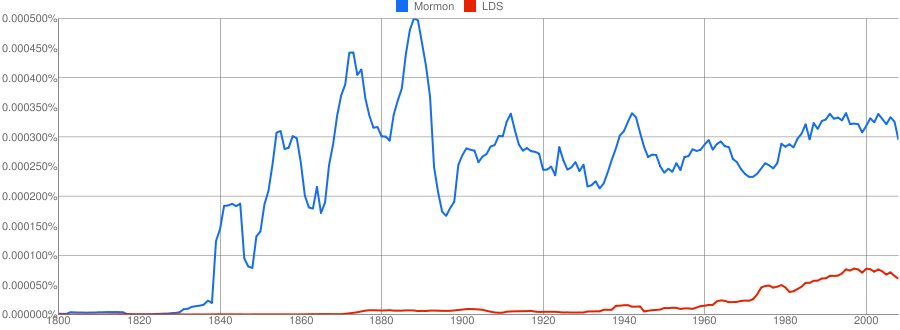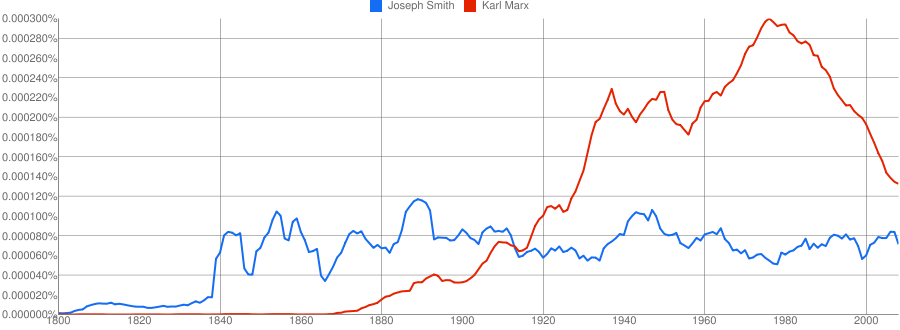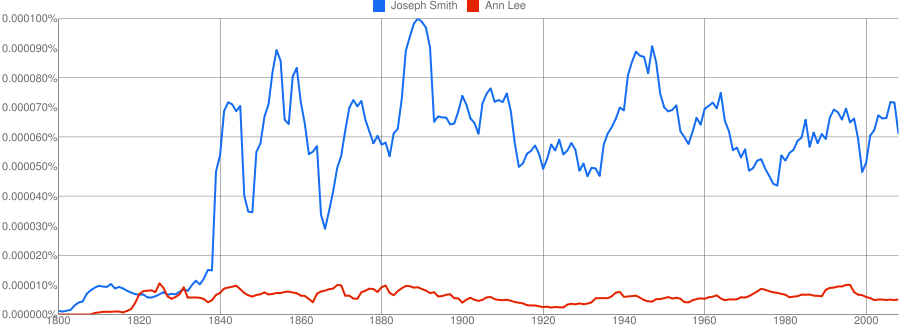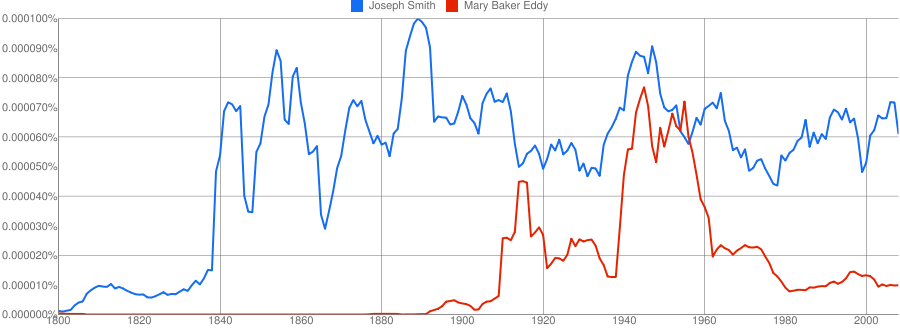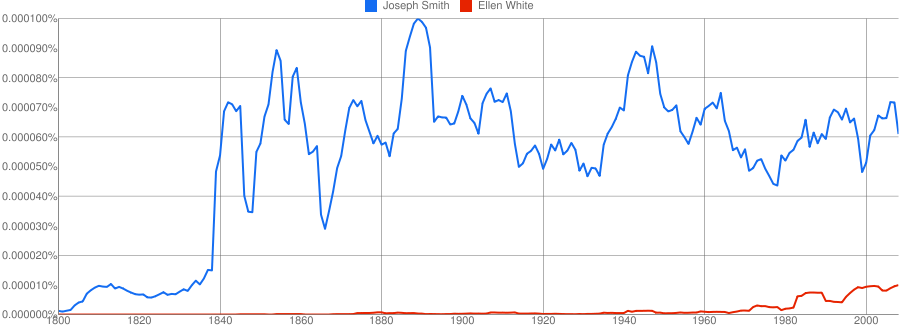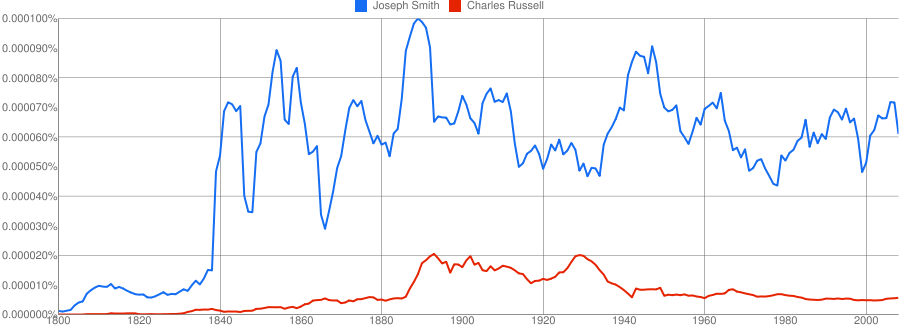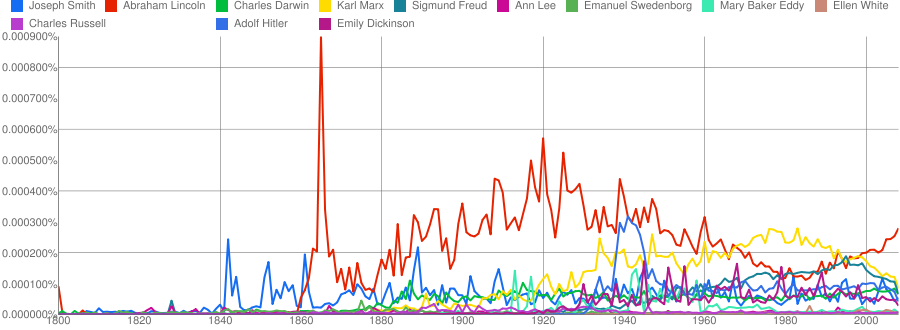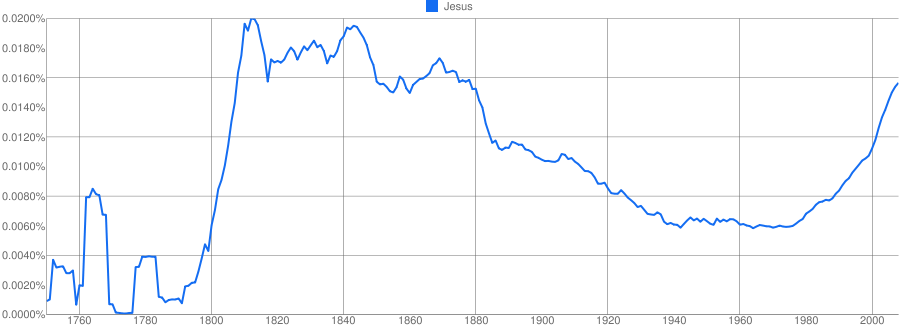You may have heard about the cool new Book Ngram Viewer from Google Labs. The result of a joint effort by Harvard University, some traditional book publishers, and Google Books, the project uses a sample of 5 million books published between 1500 and the present to identify word and phrase frequencies relative to the number of words published each year. They call these phrase frequencies Ngrams.
While the sample size only represents 4% of books ever published, and the approach is often limited by the complexity of language usage, the project offers a fascinating (not to mention fun!) look not just into language, but into comparative cultural trends, historical events, fads, celebrity, and influence.
And best of all, Google has provided a free web-based interface so that anyone can play around with Ngram searches.
For instance, the Ngram Viewer can be used to compare the usage of the terms Mormon vs LDS:
When I first became aware of the tool on Friday, one of the first things I thought of was what the angel Moroni said about the prophet Joseph Smith’s name when he first appeared to the prophet:
“He called me by name, and said unto me that he was a messenger sent from the presence of God to me, and that his name was Moroni; that God had a work for me to do; and that my name should be had for good and evil among all nations, kindreds, and tongues, or that it should be both good and evil spoken of among all people.”
I also remembered the first verse of the revelation contained in section 122 of the book of Doctrine and Covenants where the Lord declares of Joseph Smith:
“The ends of the earth shall inquire after thy name, and fools shall have thee in derision, and hell shall rage against thee;”
Joseph Smith was born on December 23, 1805; 205 years go this week. I thought it would be interesting to see what the Ngram Viewer could show concerning these prophecies about the prophet’s name compared to some other comparable religious and spiritual figures, as well as a few other influential or famous thinkers and historical characters.
After playing around with various names, I settled on the following names to compare to Joseph Smith:
- Abraham Lincoln – The 16th President of the United States
- Charles Darwin – the father of the Theory of Evolution
- Karl Marx – considered the Father of Communism
- Sigmund Freud – the father of modern Psychotherapy
- Ann Lee – the founder of the United Society of Believers in Christ’s Second Appearing, also called the Shaking Quakers or Shakers, in the U. S. in the 1770s. Doctrine & Covenants Section 49 is directed at the Shakers.
- Emanuel Swedenborg – a well known Christian mystic in the late 1700s whose visions and theology have sometimes been compared to Joseph Smith. His disciples included the father of Henry and William James. He also influenced Elizabeth Barrett Browning, Ralph Waldo Emerson, William Butler Yeats, Johnny Appleseed, Carl Jung, Helen Keller, and other well known figures.
- Mary Baker Eddy – the founder of Christian Science in the late 1800s
- Ellen White – visionary founder of the Seventh Day Adventists in the late 1800s
- Charles Russell – the founder of the Zion’s Watch Tower Tract Society in the late 1800s, which later became the Jehovah’s Witnesses
- Adolf Hitler – Infamous leader of the National Socialist German Workers Party
- Emily Dickinson – the reclusive American poet
Here are the combined results for the search:
According to this measure, Abraham Lincoln clearly has produced the greatest and longest lasting discussion among this selection. After many years of decline, he was briefly surpassed by Karl Marx after the cultural revolution of the 1960s, and a decade or so later Freud, who had been steadily increasing, was also comparable to Lincoln. Thankfully, Lincoln began to regain ground in the 1980s and has continued to do so, while Marx simultaneously declined at about the same rate as Lincoln’s resurgence, and Freud has been in decline since about the mid-1990s.
(As an aside, it is interesting that the references to Karl Marx began a steady decline about a decade before the collapse of the U.S.S.R. and the end of the cold war. I wonder what kinds of predictions we might try based on current trends?)
How does Joseph Smith fare by this measure? Interestingly, he is most comparable to Charles Darwin, Emily Dickinson, and Adolf Hitler (after the 1950s). If you are talking about names that are “had for good and evil among all nations ” and names after which “the ends of the earth shall inquire,” being in the company of the names like Darwin, Dickinson, and Hitler is quite impressive. Especially contrasted with the other religious founders in this group.
Here are individual charts for Joseph Smith and each other individual:
Joseph Smith vs Abraham Lincoln
Joseph Smith vs Charles Darwin
Joseph Smith vs Emanuel Swedenborg
Joseph Smith vs Mary Baker Eddy
Joseph Smith vs Charles Russell
Joseph Smith vs Emily Dickinson
In some ways it is hard to compare these names. For instance, I am sure that there are numerous references to the prophet as “Joe Smith” or just “Smith” that are not found by searching for “Joseph Smith”. There are also likely some Joseph Smiths that refer to individuals other than the prophet, but while a search for Joseph Smith Jr. would help exclude these, it would be too specific and miss all of the references to just Joseph Smith. So I stuck with Joseph Smith.
I then applied a similar approach to the other names. For instance, a search for “Hitler” or “Marx” would yield far more references than “Adolf Hitler” or “Karl Marx,” but because I can’t search for just “Smith” for Joseph Smith, I decided to only search for the highest yielding version of each individual’s full name. In some cases, like Charles Russell and Ellen White, that meant excluding middle names for the same reason that I excluded the Jr. for Joseph Smith, even though they may accidentally include others with the same name. In the case of Mary Baker Eddy, however, including the middle name produced higher results than without, so I used that name.
This is hardly a comprehensive study. It’s just a blog post based on my own messing around with the Ngram Viewer during a few hours. The viewer has numerous options. You can select different collections of books and languages, and change the way it averages the data. I ran all of my comparisons using the default English corpus and a smoothing of 3. Switching the smoothing option to 0, for instance, results in a chart of the raw data:
You can learn more about how the Ngram Viewer works and what its different options do here. There are still innumerable applications to this topic as well as many, many others.
Go play with it. Then share what kinds of cool things you have tried.
UPDATE 12/19/2010
My friend Brian Duffin pointed out another interesting thing. If you search the Ngrams for “Jesus” there is a huge spike in the frequency of references to Jesus that starts just before 1800 and climbs rapidly to its highest points between 1810 and 1815, and while it fluctuates, it remains high until around 1842, after which it declines quickly, resurges briefly during the Civil War, and then steadily declines until nearly 1980. Since then it has been rapidly climbing, though not quite as fast as it did in the first decade of 1800.
Interestingly, the highest spike corresponds to the years just before Joseph Smith’s birth in 1805 until he was about 10 or 11 years old. This lends support to the prophet’s declaration that in about 1817 “there was in the place where we lived an unusual excitement on the subject of religion.” Apparently there was an unusual excitement, not just in the region where he lived, but in the English Language in general. The frontier folk may have been behind the trend by a few years.
Also interesting, the excitement remains relatively high throughout the prophet’s life, getting nearly has high toward the end of his life as the beginning, and then begins its rapid decline almost exactly when Joseph Smith is murdered in 1844.
Thanks Brian!
Share on:











Continue reading at the original source →




